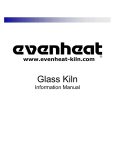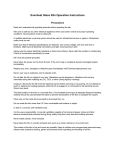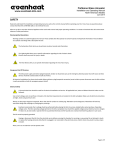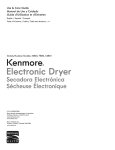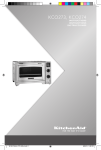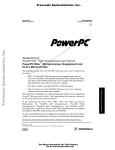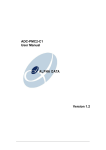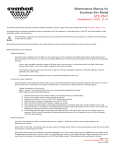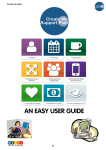Download Kingpin 88 Kingpin 88 Features
Transcript
Kingpin 88 Installation and Operating Manual North American and Global Models April 2011 Thank you for purchasing the Kingpin 88 by Evenheat Kiln. The Kingpin 88 brings you classic design with Evenheat performance. Kingpin 88 Features Set‐Pro Control with Express Mode and 4 User Programs The Kingpin 88 is equipped with our Set‐Pro with Express Mode, 3 button control. The Set‐Pro with Express Mode is loaded with 10 pre‐set metal clay firing programs (5 for Art Clay and 5 for PMC) for quick and easy programming. Express Mode programs include PMC Standard, PMC+, PMC3 (slow), PMC3 (fast), PMC Gold, Art Clay Silver Standard, Art Clay Silver Standard Slow Dry, Art Clay 650/1200 Low Fire, Art Clay Silver 650/1200 Low Fire Slow Dry and Art Clay Copper. The Set‐Pro also contains 4 custom programs that allow you to decide the firing details such as with glass firing, bead annealing and non‐metal clay firing. As with all of our controls, the Set‐Pro is manufactured exclusively for Evenheat by Bartlett Instrument Company in Iowa. Bartlett enjoys a well deserved reputation as the finest control supplier on the market. They perform very well indeed. Embedded Heating Elements The heating elements of the Kingpin 88 are completely embedded within the chamber fiber for safety. Especially important with Bead Door equipped models. The heating elements of the Kingpin 88 are located along the left and right side of the firing chamber. This design provides for excellent temperature distribution throughout the kiln. You’ll love the results. Angled Control for Comfortable Use The control on the Kingpin 88 is positioned at a friendly viewing and programming angle. It’s a thoughtful design feature and a detail you expect from Evenheat. Standard Household Plug The Kingpin 88 is designed for use on standard household voltage and current. Simply plug into any dedicated household receptacle and you're ready to go. Attractive Powder Coat Finish The exterior of the Kingpin 88 is finished in an appealing powder coat finish. Powder coating is a finishing method that provides great looks with greater protection against scuffs and scratches than paint. Powder coating has the added advantage of being environmentally friendly to apply. Cool‐Touch Handles We've designed the Kingpin 88 with a non‐metallic, Cool‐Touch handles that stays cool throughout the firing process. Sizable Firing Chamber The Kingpin 88’s firing chamber is “personal studio” sized allowing the artist room to fire multiple pieces at once. Wide Opening Door The door on the Kingpin 88 swings out fully (180°+) for easy access to the firing chamber. Well Ventilated Enclosure The enclosure on the Kingpin 88 is very well ventilated to help keep internal control components cool and operating properly. Strategically placed inner baffles act as additional protection against heat. Longer life, high reliability: solid design makes a difference. Page 1 of 4 Kingpin 88 Installation and Operating Manual North American and Global Models April 2011 Kingpin 88 Features cont. Door Options The Kingpin 88 is offered with a bead door for those who enjoy annealing glass beads. The bead doors on the Kingpin 88 feature a wide 7‐1/2” opening as well as 15 mandrel teeth for maximum use. The bead door also features a soft, flexible fiber seal that forms slightly around the bead mandrel for added stability. Vented Chamber with Vent Plug The firing chamber of the Kingpin 88 is vented and is equipped with a vent plug. Venting is desirable during many heat processes, particularly lost wax casting. Cautions / Safety Precautions Read and follow all Cautions, Precautions and Operating Instructions Do not touch kiln surfaces when firing. When touching otherwise, approach slowly. Keep unsupervised children away from kiln. The kiln should only be placed on a stable, level and noncombustible surface and should be no closer than 12” from any wall or 48” from any ceiling (in both the open and closed positions). Remove all flammable materials from the kiln work area. Keep combustible material away from kiln. Fire only in a well ventilated area. Do not fire in small, enclosed, closet type areas. Never use an extension cord with a kiln. Use protective eyewear when viewing firing. Eyewear should be capable of filtering both Infrared and Ultraviolet light (IR and UV). Wear protective gloves when operating the kiln. Gloves should be of the type that offer protection up to the chamber temperatures expected during the firing. Also, if possible, choose gloves that give a fair range of motion. Bulky, stiff gloves may not offer much confidence in use. Always turn the kiln OFF before entering. Making contact with electrically energized heating elements can cause serious injury or death. Don’t touch the elements with anything. Do not leave the kiln unattended when firing. Never fire organic materials in the kiln. When firing is completed always unplug the kiln Page 2 of 4 Kingpin 88 Installation and Operating Manual North American and Global Models April 2011 Kiln Setup and Placement Kiln Location Place your Kingpin 88 in a location that offers a level, non combustible surface. The Kingpin 88 should be placed no closer than 12” from any wall or 48” from any ceiling surface in all opened and closed positions. All flammable and combustible materials should be removed from the kiln area. Enjoy your kiln safely. Kiln Operation Plugging In the Kingpin 88 Plug the Kingpin 88’s power plug into your standard household outlet. As the Kingpin 88 requires 12A/120V to operate, it’s best that it be the only devise plugged into the circuit. Once you plug it in make sure the power cable is not touching the kiln. Your Firing Surface We suggest that you use a firing shelf, prepared with kiln wash or glass separator, for all Kingpin 88 firings. You may also choose to fire on many of the fiber “papers” available. These shelves are available from Evenheat. We suggest that you DO NOT place your ware directly on the chamber floor. If a firing fault occurs it is much easier (and cheaper) to replace the shelf than the firing chamber. The exception to this rule is that bead annealers may place beads directly on the chamber floor. Pre Fire Evenheat suggests that you perform a test fire with your new kiln before putting it into service. A pre fire gives you an opportunity to become familiar with the features and functions of the kiln before committing to an actual firing. A light lubricant was used in the production of your heating elements. The pre fire will burn this off, almost immediately! You may notice a light smoke as this occurs. It’s normal. The Kingpin 88 should not be loaded with any ware for the pre fire operation. We would suggest using an actual firing program that you are likely to use. Your Kingpin 88 was shipped with a Set‐Pro control manual. Please refer to that manual for programming instructions. As you run the pre fire keep an eye on the kiln to get a feel of how it functions. You’ll notice a slight clicking sound from the control relay and an increase in chamber temperature. Once the pre fire is complete allow the chamber to assume room temperature before opening. We would encourage you to repeat this pre fire procedure if you’ve never fired a kiln of this design before. You won’t hurt anything. Kilns are wonderful machines and they’re even more wonderful when you know what to expect and how to work them. Loading the Kingpin 88 for Firing Always load and unload the Kingpin 88 with the power switch thrown to the OFF position. The Kingpin 88 must always be at or near room temperature before loading. With the power switch thrown to the OFF position, pull on the door handle to open. Place your prepared shelf and ware into the firing chamber. Close the door until the door latch snaps shut. The door latch is a spring loaded design and closing pressure may be adjusted. Simply use a slotted screw driver to increase or decrease closing pressure. Firing the Kingpin 88 All firing operations are performed by the Set‐Pro control. Refer to the included Set‐Pro manual for programming instructions. Do not open the kiln during firing. Doing so presents a burn hazard. High heat escapes very quickly. Page 3 of 4 Kingpin 88 Installation and Operating Manual North American and Global Models April 2011 Kiln Operation cont. Unloading the Kingpin 88 The Kingpin 88 must always be at or near room temperature before unloading. Do not open or unload the kiln if chamber temperature is not at or near room temperature. Always load and unload the Kingpin 88 with the power switch thrown to the OFF position. With the power switch thrown to the OFF position, pull on the door handle to open. Remove your ware and prepared shelf. Close the door until the door latch snaps shut. Firing Cautions and Tips Crash or Flash Venting Caution: There is a technique called “Crash Venting” or “Flash Venting” that is used in some firing procedures, most notably glass firing. This involves opening the kiln at high temperature in an attempt to cool it very quickly and to stop any further changes to the glass. It’s a valid and popular technique but it does come with some risk. Specifically: risk of burns. If you attempt this procedure be aware that the hot gases in the kiln will escape very quickly. First and Foremost – Keep Your Face Away and Stand Back. Wear eye protection capable of filtering Infrared and Ultraviolet light (IR and UV), gloves capable of surviving expected chamber temperatures and loose fitting cotton clothing. Also be aware of your surrounding environment. Always make sure there are no flammable or combustible materials near. You should be doing this anyway but be aware. When the door is opened a lot of heat comes pouring out quickly and it needs to go somewhere so give it plenty of room. After the bulk of the heat has escaped you may wish to approach the kiln more closely. If so, do so slowly and with care. Ware Manipulation Caution: Some firing techniques involve using manipulation tools or require chamber access during the firing process. Before using any such techniques throw the power switch to the OFF position. Not doing so creates an unsafe condition. Making contact with energized heating elements is dangerous and may cause serious injury or death. Also please note that there is a burn risk. If you attempt any procedures involving opening and/or entering a kiln that is firing be aware that the hot gases in the kiln will escape very quickly. First and Foremost – Keep Your Face Away and Stand Back. Wear eye protection capable of filtering Infrared and Ultraviolet light (IR and UV), gloves capable of surviving expected chamber temperatures and loose fitting cotton clothing. Also be aware of your surrounding environment. Always make sure there are no flammable or combustible materials near. You should be doing this anyway but be aware. When the door is opened a lot of heat comes pouring out quickly and it needs to go somewhere so give it plenty of room. After the bulk of the heat has escaped you may wish to approach the kiln more closely. If so, do so slowly and with care. Venting Venting: Venting is a fairly common procedure used during the firing process. It helps to bring fresh oxygenated air into the firing chamber while expelling depleted air and burn off. This is particularly useful when color or adhesives are involved. Venting can also be used to speed up the cooling process. Generally speaking, venting usually occurs in the beginning of the firing when burn off from adhesives, decals or other related materials is expected. Once the kiln reaches “Red Heat” (about 1000°F) it’s generally acceptable to close the vent. Keep in mind that venting requires manipulating the door and/or vent plug (located at top of kiln) and venting while the kiln is firing means it’s going to be hot. First and Foremost – Keep Your Face Away and Stand Back. Wear eye protection capable of filtering Infrared and Ultraviolet light (IR and UV), gloves capable of surviving expected chamber temperatures and loose fitting cotton clothing. Also be aware of your surrounding environment. Always make sure there are no flammable or combustible materials near. You should be doing this anyway but be aware. When the door and/or vent plug are opened or removed some heat does come out quickly and you do. Page 4 of 4




